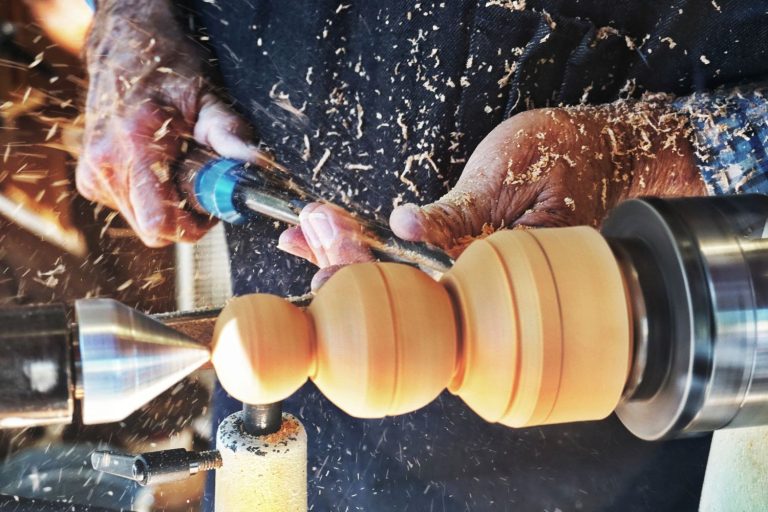Best Miter Saw to Perfect Your Angles
Are you tired of trying to make straight cuts with your hand saw and tape measure?
Have the “unprofessional” angles of your cutting projects driven you (or your significant other) crazy?
It’s time to get serious about woodworking – it’s time to find the best miter saw for perfect angles!
The miter saw is an essential tool for both DIYers and pros alike, making precise angled cuts a snap.
In this article, we’ll help guide you every step of the way in finding the right miter saw for all your cutting needs.
We’ll give insight into what to look for so that when it comes time to make those crucial angled edges–no matter how complicated–you can have complete confidence in achieving great results.
How We Choose the Best Miter Saws
Looking for a new miter saw can be overwhelming – how do you know which features to look for, what brands are the best, and whether you’re getting the most value for your money?
You don’t want to make a mistake and buy the wrong product!
Not only would that be a waste of time and money, but it would also mean having to start your search all over.
But fret not!
We read through thousands of reviews on Amazon and compared the features and specs of the top brands to narrow it down to these miter saws.
So now you can make an informed decision quickly, easily – and confidently.
Overall Winner – Best Miter Saw
DEWALT 12-Inch Dual-Bevel Sliding Compound Miter Saw (DWS779)
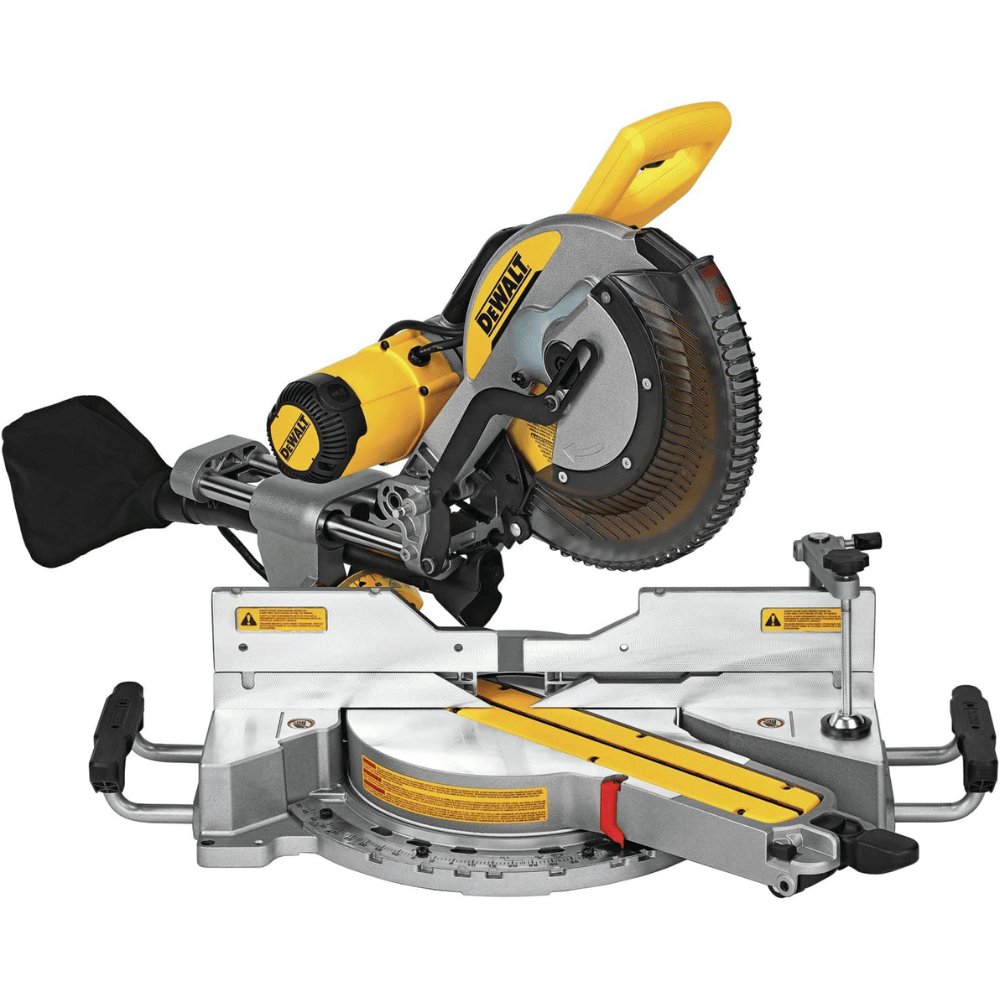
Key Features
- 15 amp motor spins the blade at up to 4,000 RPM
- Cuts 2″ x 14″ dimensional lumber at 90 degrees
- The fence supports up to 6-3/4″ vertical baseboard
Why It’s a Great Choice
Introducing the DEWALT Dual-Bevel Sliding Compound Miter Saw – all you need to get the job done faster and more accurately.
It’s a powerful combo of precision and performance, with stainless steel miter scales on the detent plate and 10 positive stops built in for rapid accuracy.
The massive saw offers the capacity to cut 2″ x 14″ dimensional lumber at 90 degrees or 2″ x 10″ lumber at 45 degrees guaranteeing a perfect cut no matter how demanding the job.
You also get dual bevels from 0 – 48 degrees left or right as well as dual horizontal steel rails with innovative clamping mechanisms and linear ball bearings for increased durability.
All this makes for a quick and easy setup, perfect for DIYers or professionals alike – so what are you waiting for?
Get your DEWALT Dual-Bevel Sliding Compound Miter Saw today!
Best Compound Sliding Miter Saw
BOSCH 12-Inch Corded Dual-Bevel Sliding Glide Miter Saw (GCM12SD)
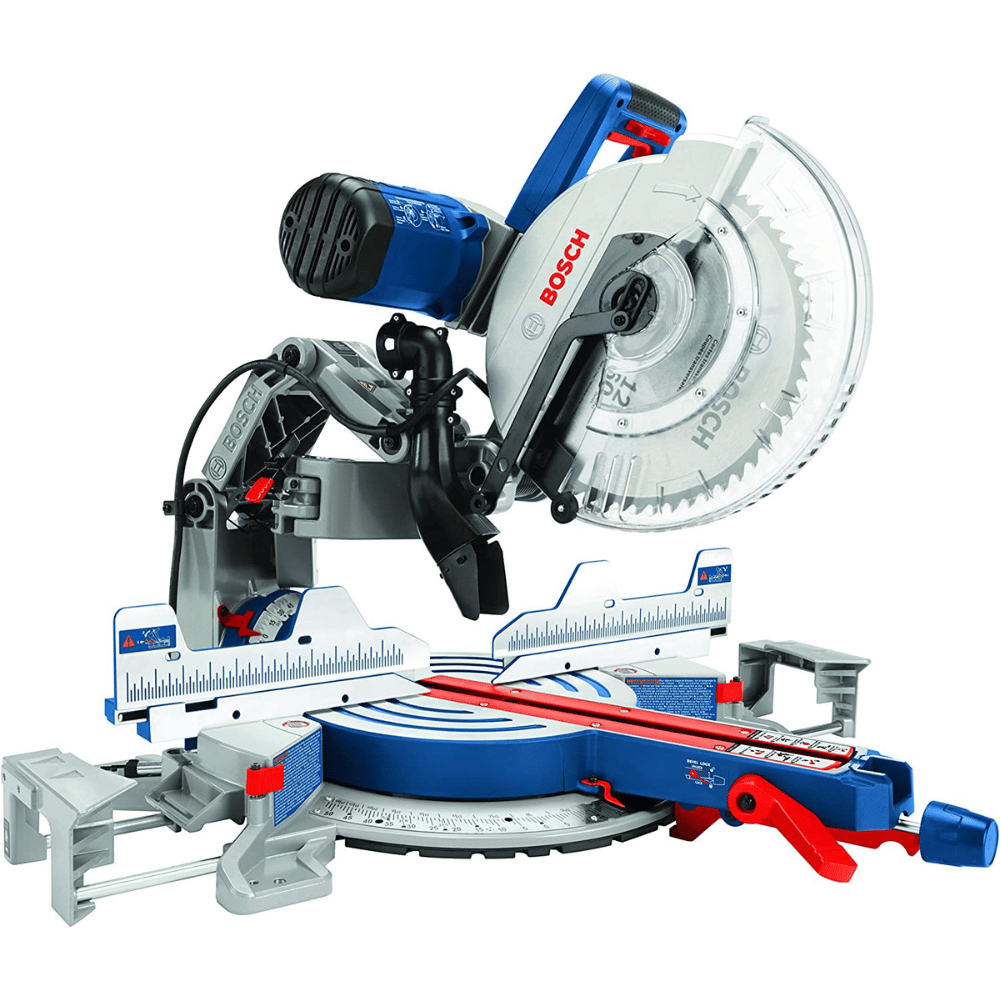
Key Features
- 15 amp motor spins the blade at up to 3,800 RPM
- Cuts 2″ x 14″ dimensional lumber at 90 degrees
- The fence supports up to 6-1/2″ vertical baseboard
Why It’s a Great Choice
The new BOSCH Dual-Bevel Sliding Glide Miter Saw is the ultimate weapon for DIYers and professionals alike!
This top-of-the-line saw is designed to give you the precision that lasts with its exclusive Axial-Glide system.
Plus, you don’t have to worry about adjusting the fence for added support – with a quick-release Squarelock fence, your projects will be faster and easier to setup than ever before.
But what truly sets this saw apart from the rest is its wide range of cutting capabilities.
With a 14-inch expanded horizontal cutting capacity, 6-1/2-inch vertical capacity, and a 6-1/2 crown capacity (45-degree spring), you can tackle any project with confidence!
And if all those options weren’t enough, the easy adjustments and clear markings make even complex cuts a breeze.
So don’t wait any longer – unlock the power of professionalism with the Bosch Dual-Bevel Sliding Glide Miter Saw.
Cut through anything without skipping a beat!
Best Compact Miter Saw
Makita Brushless Cordless Compact Dual-Bevel Compound Miter Saw (XSL05Z)
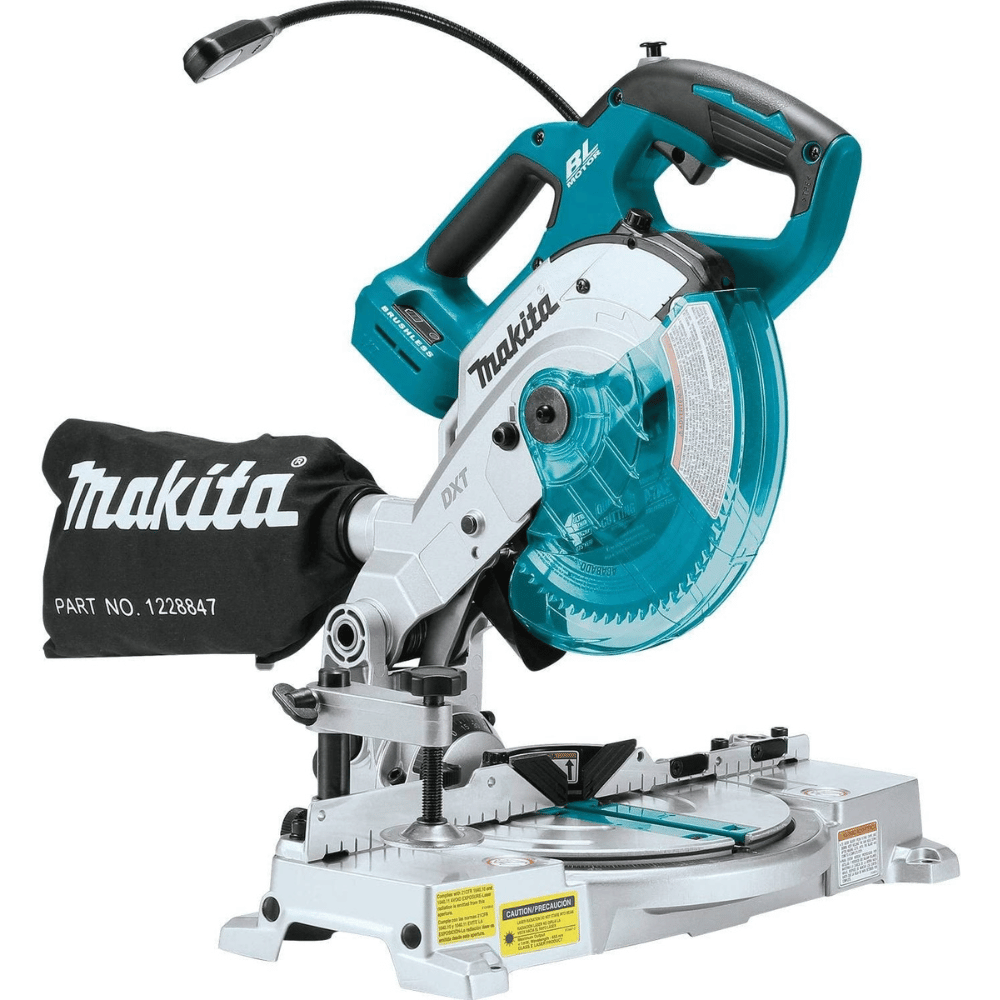
Key Features
- Works with Makita’s 18V LXT Lithium-ion battery (not included)
- Cuts 2″ x 4″ dimensional lumber at 90 degrees
- The fence supports up to 3-1/2″ vertical baseboard
Why It’s a Great Choice
Who said sawing had to be a chore?
The Makita Cordless Compact Dual-Bevel Compound Miter Saw isn’t just up for the task, but it looks forward to it!
Forget lugging around heavy tools and cords – this lightweight saw makes sawing a breeze, weighing in at only 14.6 lbs with a battery.
Even better, its automated speed change technology means that your cuts always come out looking fantastic by automatically adjusting cutting speed and torque during the process.
You can even get up to 270 cuts in 1/2″ x3-1/2″ baseboards using just one 6.0Ah battery thanks to Makita’s powerful LXT technology.
And if that wasn’t good enough already, its motor’s brushless design means even more efficiency allowing it to run cooler and more efficiently.
From amateur DIYers to professionals and everyone in between – this ultimate saw is perfect for making all those precision cuts!
Best Sliding Compound Miter Saw on a Budget
Skil 10″ Dual-Bevel Sliding Compound Miter Saw (MS6305-00)
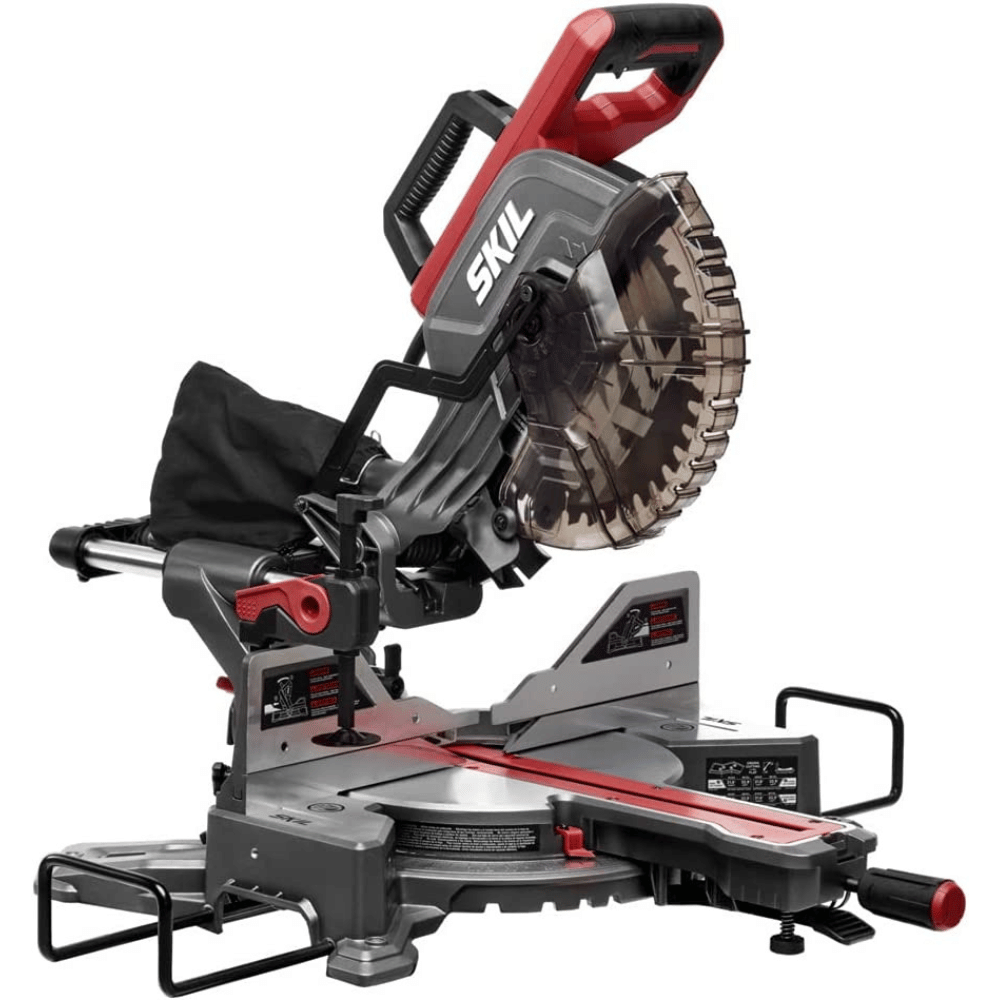
Key Features
- 15 amp motor spins the blade at up to 4,800 RPM
- Cuts 2″ x 12″ dimensional lumber at 90 degrees
- The fence supports up to 4-1/2″ vertical baseboard
Why It’s a Great Choice
The new Skil 10″ Dual-Bevel Sliding Compound Miter Saw is the saw that truly likes to make a statement!
A lightweight and portable saw equipped with features that will take your DIY projects out of this world.
The horizontal grip handle with a center-located safety trigger caters to both right and left-handers, allowing everyone to work in their natural position, maximizing comfort and accuracy.
It also has 9 detents on the stainless-steel miter plate and 11 miter locations giving you the potential to create up to 50-degree cuts within seconds.
Loud and proud, we can guarantee precision all thanks to the LED Shadow Line which ensures accuracy beyond traditional lasers.
To ensure ease of use, SKIL has added a cam miter lock knob too, for perfect repeatable accuracy and easy adjustments every time!
So if you’re looking for more professional results for your DIY projects – this is the saw for you!
Get your Skil 10″ Dual-Bevel Sliding Compound Miter Saw today for the precision results you need!
Best 10″ Cordless Miter Saw
Milwaukee M18 Fuel Dual-Bevel Sliding Compound Miter Saw (2734-21HD)
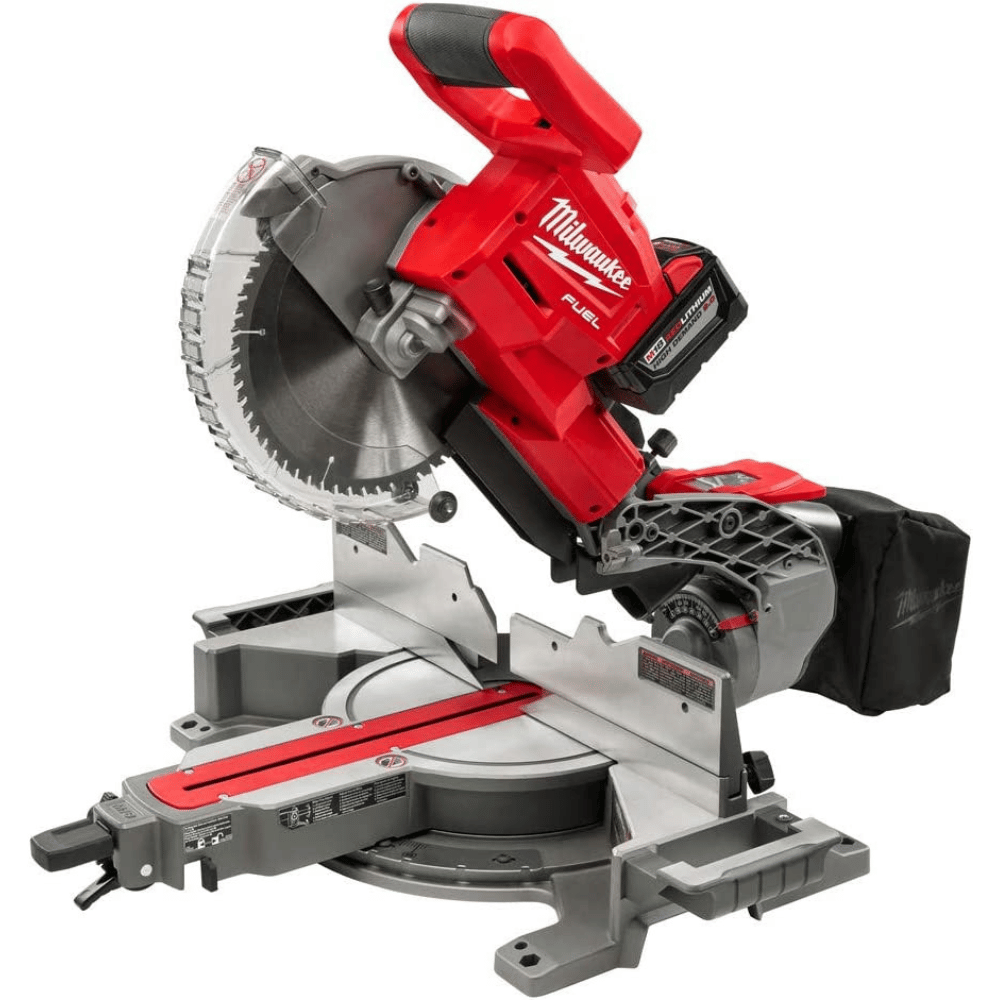
Key Features
- Works with Milwaukee’s 18V Lithium-ion battery (included)
- Cuts 2″ x 12″ dimensional lumber at 90 degrees
- The fence supports up to 5-3/4″ vertical baseboard
Why It’s a Great Choice
The Milwaukee M18 Fuel Dual-Bevel Sliding Compound Miter Saw is powerful enough for professionals but friendly enough for DIYers.
This is one tool that’s sure to have you crowing with delight!
Delivering more cutting power and capacity than many corded 10″ sliding miter saws, this state-of-the-art saw packs a real punch.
With an adjustable stainless steel detent plate, cam locking miter system, easy access bevel adjustment lever, and both a detent override lock and chop lock lever located on the front of the tool, you’ll have complete control over all your projects.
Not to mention, its POWERSTATE brushless motor means you get corded performance without being tethered to a power source.
Even better?
The M18 RedLithium high-demand 9.0 Battery pack gives you 400 cuts per charge, meaning your job site won’t be shutting down any time soon.
Meanwhile, REDLINK Plus Electronic Intelligence allows for unparalleled levels of performance, protection, and productivity- what more could you ask for?
So don’t just take our word for it – get your hands on this powerhouse of a miter saw today!
Buyer’s Guide to the Best Miter Saws
Shopping for a miter saw can be confusing and overwhelming.
With a huge selection of brands, types, and prices on the market, how do you know which one is the best choice?
You don’t want to be stuck with an expensive saw that doesn’t fit your needs or worse yet, a saw that doesn’t even last long enough to give it a fair trial.
That’s where we come in.
We’ve put together these FAQs to steer you in the right direction so you can find the perfect miter saw for your needs – without breaking the bank!
What is a miter saw, and how does it differ from other types of saws?
A miter saw is a specialized power saw used to make precise and angled cuts in wood, metal, or other materials. It typically has a circular blade that is mounted on a swinging arm, which can pivot left or right to cut at different angles. The main difference between a miter saw and other types of saws, such as a circular saw or a table saw, is that it allows for accurate and consistent angled cuts, making it an ideal tool for trim work, woodworking, and other precision cutting tasks. Additionally, many miter saws are equipped with features such as laser guides, adjustable stops, and sliding mechanisms that enhance their functionality and versatility.
What are some tips for getting the best results from my miter saw?
Here are some tips for getting the best results from your miter saw:
- Choose the right blade: Select a blade that is appropriate for the material you are cutting and the type of cut you want to make.
- Check your angles: Make sure that your miter saw is properly set up and calibrated, and that you have adjusted the angle and bevel settings to the desired angles.
- Secure your workpiece: Use clamps or other methods to securely hold your workpiece in place and prevent it from shifting or moving during the cutting process.
- Use proper technique: Always use the proper technique when operating your miter saw, including keeping your hands and fingers away from the blade, using a steady and controlled motion, and following all safety precautions.
- Take your time: Don’t rush the cutting process, and take your time to ensure that you are making precise and accurate cuts.
- Keep your saw clean: Regularly clean your miter saw and remove any debris or sawdust that may have accumulated, as this can affect the accuracy and performance of the saw.
By following these tips, you can ensure that you are getting the best possible results from your miter saw and that you can make precise and accurate cuts with ease.
How do I know if a miter saw is the right tool for my specific woodworking project?
Whether a miter saw is the right tool for your specific woodworking project depends on the type of cuts you need to make and the materials you are working with. Here are a few factors to consider:
- Cut angle: Miter saws are designed for making angled cuts, so if your project requires precise and consistent angled cuts, a miter saw may be the ideal tool.
- Material: Miter saws are primarily used for cutting wood, but some models are also suitable for cutting metal or other materials. Make sure to select a miter saw with a blade that is appropriate for the material you are working with.
- Cut size: Miter saws are best suited for making smaller, more precise cuts, so if you need to make larger cuts, a circular saw or table saw may be a better choice.
- Project type: Miter saws are commonly used for trim work, molding, and other precision cutting tasks, but may not be the best choice for larger construction or framing projects.
Ultimately, the best way to determine whether a miter saw is the right tool for your specific woodworking project is to carefully consider your needs and the type of cuts you need to make and to consult with an experienced woodworking professional or salesperson who can help you select the right tool for the job.
What are bevel cuts?
Bevel cuts are angled cuts made along the thickness or depth of a workpiece. Unlike a miter cut, which is made by angling the blade of the saw along the width of the workpiece, a bevel cut is made by tilting the blade of the saw to an angle relative to the surface of the workpiece. Bevel cuts are commonly used in woodworking and other industries to create angled edges, chamfers, and other decorative or functional features. Most miter saws are equipped with a bevel adjustment feature that allows the user to easily adjust the angle of the blade and make precise and accurate beveled cuts.
What are miter cuts?
Miter cuts are angled cuts made across the width of a workpiece, typically at 45 or 90-degree angles. They are commonly used in woodworking and other industries to create precise corners and joints, such as in picture frames or molding. Miter cuts are made by adjusting the angle of the saw blade on a miter saw or other cutting tool to the desired angle, and then carefully cutting through the workpiece to create a clean and accurate cut. The accuracy and precision of miter cuts are important for ensuring that the pieces fit together properly and create a professional-looking finished product.
What are miter scales?
Miter scales are markings or guides on a miter saw or another cutting tool that indicates the angle of a miter cut. They are usually located on the saw’s base or fence and are used to help the user make accurate and precise cuts at specific angles, such as 45 or 90 degrees. Miter scales may be marked in degrees or fractions of a circle, and some may also include additional markings for bevel cuts or other types of cuts. By aligning the blade of the saw with the appropriate marking on the miter scale, the user can ensure that their cuts are consistent and accurate, making it easier to achieve a professional-looking finished product.
Why is a miter saw better than a table saw or handheld circular saw?
A miter saw is not necessarily better than a table saw or handheld circular saw – each tool has its strengths and weaknesses, and the best tool for a particular job depends on the specific requirements of the project.
However, a miter saw is often the preferred tool for making accurate and precise miter cuts and crosscuts at specific angles. Miter saws typically have a range of angle settings, making it easy to make consistent and accurate cuts at precise angles. They also have a fixed base that allows for stable and repeatable cuts, which can be especially useful for cutting longer or thicker pieces of wood.
Table saws, on the other hand, are more versatile and can handle a wider range of cutting tasks, including rip cuts, crosscuts, and bevel cuts. They are also better suited for cutting larger or thicker pieces of wood. Handheld circular saws are portable and can be used for a variety of cutting tasks, but are generally not as precise as miter saws or table saws.
In summary, while each tool has its advantages, a miter saw is often the preferred tool for making accurate and precise miter cuts at specific angles.
Are cordless miter saws worth the investment?
Cordless miter saws can be a good investment for those who need the portability and convenience that cordless tools provide. They offer the ability to work in areas without access to a power outlet and can be easily transported to job sites or other locations.
However, there are some considerations to keep in mind before investing in a cordless model. Cordless tools are typically less powerful than their corded counterparts, which may make them less suitable for heavy-duty or demanding cutting tasks. Additionally, cordless saws may have a shorter battery life, which could limit their use time and require additional batteries to be purchased.
Another factor to consider is the cost. Cordless saws tend to be more expensive than corded models, and the cost of replacement batteries and chargers can also add up over time.
In summary, a cordless miter saw can be a good investment for those who need the portability and convenience that they provide, but it’s important to carefully consider their power, battery life, and cost before making a purchase.
What accessories should I consider for my miter saw?
Several accessories can enhance the functionality and versatility of a miter saw. Some of the most common accessories to consider include:
- Stand: A miter saw stand can provide a stable and secure base for the saw, making it easier to use and maneuver.
- Laser guide: A laser guide can help to improve the accuracy of your cuts by projecting a beam of light onto the workpiece.
- Dust collection system: A dust collection system can help to keep your workspace clean and free of debris, improving safety and reducing cleanup time.
- Extension wings: Extension wings can increase the size of your work surface, making it easier to work with larger or longer pieces of wood.
- Crown molding jig: A crown molding jig can help to simplify the process of cutting crown molding, ensuring that the pieces fit together properly.
- Clamps: Clamps can help to hold your workpiece securely in place, reducing the risk of accidents or mistakes.
- Blades: Different types of blades can be used to achieve different types of cuts, so it’s important to choose the right blade for your specific needs.
In summary, several accessories can enhance the functionality and versatility of your miter saw, including a stand, laser guide, dust collection system, extension wings, crown molding jig, clamps, and blades.
What are some common problems I might encounter when using a miter saw?
While miter saws are generally reliable and efficient tools, there are a few common problems that you may encounter when using them. Some of the most common problems include:
- Inaccurate cuts: This is one of the most common problems and can be caused by several factors, such as a dull blade, incorrect blade angle, or incorrect fence alignment.
- Dust and debris: Miter saws can produce a lot of sawdust and debris, which can accumulate on the saw and surrounding area, potentially causing safety hazards or interfering with the accuracy of your cuts.
- Motor problems: Issues with the motor can cause the saw to stall or operate erratically, which can be dangerous and may require repair or replacement of the motor.
- Blade problems: A dull or damaged blade can cause the saw to vibrate excessively, produce inaccurate cuts, or even pose a safety hazard.
- Fence problems: The fence is the part of the saw that guides the workpiece during cutting, and if it is not properly aligned, it can cause inaccurate cuts or safety hazards.
- Safety issues: Miter saws can be dangerous if not used properly, and problems such as loose or damaged safety guards or improper use of the saw can lead to accidents and injuries.
In summary, some common problems you may encounter when using a miter saw include inaccurate cuts, dust and debris buildup, motor and blade problems, fence issues, and safety hazards. Many of these problems can be prevented by proper maintenance and safe use of the saw.
What are the advantages of a sliding miter saw?
Sliding miter saws offer several advantages over standard miter saws, including:
- Increased cutting capacity: A sliding miter saw has a rail system that allows the saw to slide back and forth, increasing the cutting capacity and allowing you to cut wider pieces of wood.
- Versatility: With the ability to make both miter and bevel cuts, a sliding miter saw is more versatile than standard miter saws.
- Improved accuracy: The sliding mechanism of a sliding miter saw allows for more precise and controlled cuts, resulting in improved accuracy.
- Efficiency: A sliding miter saw is generally faster and more efficient than standard miter saws, allowing you to complete your projects more quickly and easily.
- Convenience: A sliding miter saw is designed to be more convenient and user-friendly, with features such as easy-to-read miter scales and quick-release fences.
- Smooth operation: Because of its sliding mechanism, a sliding miter saw tends to operate more smoothly and with less vibration than standard miter saws.
In summary, sliding miter saws offer increased cutting capacity, versatility, improved accuracy, efficiency, convenience, and smooth operation, making them a popular choice for many woodworkers and DIY enthusiasts.
What are the advantages of a compound miter saw?
A compound miter saw offers several advantages over standard miter saws, including:
- Versatility: A compound miter saw can make both miter and bevel cuts, allowing you to make angled cuts in two planes at the same time. This makes them more versatile than standard miter saws.
- Increased cutting capacity: A compound miter saw typically have a greater cutting capacity than standard miter saws, allowing you to cut larger and thicker pieces of wood.
- Precision: The ability to make compound cuts allows for greater precision and accuracy in your work, making compound miter saws a popular choice for woodworking and carpentry projects.
- Efficiency: A compound miter saw is generally faster and more efficient than standard miter saws, allowing you to complete your projects more quickly and easily.
- Convenience: A compound miter saw is designed to be more convenient and user-friendly, with features such as easy-to-read miter scales and quick-release fences.
- Safety: A compound miter saw typically comes with safety features such as a blade guard and a safety switch, making it a safer choice for woodworking and carpentry projects.
In summary, compound miter saws offer versatility, increased cutting capacity, precision, efficiency, convenience, and safety, making them a popular choice for many woodworking and carpentry projects.
Choosing the Best Miter Saw for You
No matter which of the above miter saws you choose, you can be sure that you will make all the right cuts.
By following our guide, you now have a better understanding of some of the basic features and differences between each of these power tools.
Now that we’ve narrowed down your choices to these great options, it is time to decide which one best fits your needs.
Whether you choose one of the sliding compound miter saws or a compact miter saw, take our advice—click the links to check the prices on Amazon and place your order sooner rather than later!
Even DIY veterans have been known to get excited about picking up something new for their next project – just remember not to miter fast and furious out there!


